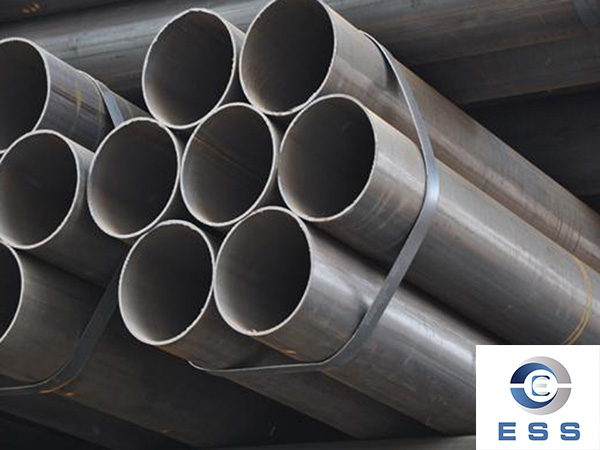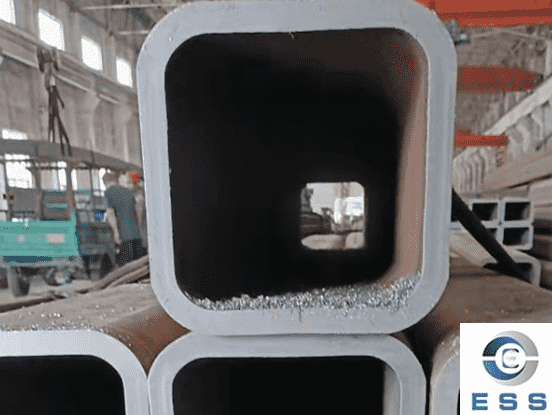Basic introduction
ERW pipe is a general term for electric resistance welded steel pipes, and straight seam high frequency electric resistance welded pipes are referred to as ERW, which are the first letters of the corresponding English words. Electric resistance welded steel pipes are divided into two forms: AC welded steel pipes and DC welded steel pipes.
AC welding is divided into low frequency welding, intermediate frequency welding, super intermediate frequency welding and high frequency welding according to the different frequencies. High-frequency welding is mainly used for the production of thin-walled steel pipes or ordinary thick-walled steel pipes, and high-frequency welding is divided into contact welding and induction welding. DC welding is generally used for small diameter steel pipes.
Therefore, in general, high-frequency welded pipe is included in ERW welded pipe, which is a kind of ERW welded pipe produced by high-frequency welding process. ERW straight seam welded pipe is a steel pipe with advanced product performance, leading quality and relatively economical in the field of oil and gas storage and transportation.
ERW straight seam welded pipes are generally used as wire casings in the electric power industry. Performance characteristics: 100% ultrasonic testing of the base material ensures the inherent quality of the pipe body; there is no unwinding-disc shearing process, and the base material is pressed pits , less scratches; the finished pipe after stress relief basically has no residual stress; the weld is short, and the probability of defects is small; the wet sour natural gas can be transported conditionally; after the diameter is expanded, the geometrical accuracy of the steel pipe is high; After the molding is completed, it is carried out in a horizontal position along a straight line. Therefore, the staggered edge, the slit, the diameter and the circumference of the pipe are well controlled, and the welding quality is excellent. The main products of Tianjin Shenzhoutong Steel Pipe Co., Ltd. are divided into three categories: two straight seam steel pipe production lines, product specifications Ф114.3mm-Ф508mm, wall thickness 3.58mm-16.3mm. Ten spiral pipe production lines, product specifications Ф219.1mm-Ф3000mm, wall thickness 5mm-30mm. There are two production lines for oil casing and casing, with product specifications Ф60.32mm-Ф508mm and wall thickness 4.24mm-16.3mm. There are two anti-corrosion and thermal insulation production lines. The annual output of steel pipes reaches 500,000 tons.
Product executable standards: API 5L, API 5CT, ASTM, EN10219-2, GB/T9711, 3091-20081, 3793-2008, 14291-2006 and other latest international standards. Product steel grades include: GRB, X42, X52, X60, X65, X70, J55, K55, N80, L80, P110, and other steel grades. Products are widely used in oil, natural gas, gas, coal, machinery, electricity, piling and other purposes.

Technical standard
According to GB/T3092 "Welded Steel Pipes for Low-Pressure Fluid Conveying", the nominal diameter of the welded pipe is 6~150mm, the nominal wall thickness is 2.0~6.0mm, and the length of the welded pipe is usually 4~10 meters. The length of the ruler is ex-factory. The surface quality of the steel pipe should be smooth, and no defects such as folds, cracks, delaminations, and lap welding are allowed. The surface of the steel pipe is allowed to have minor defects such as scratches, scratches, dislocation of welds, burns and scars that do not exceed the negative deviation of the wall thickness. Allows for increased wall thickness at the weld and the presence of internal weld ribs.
The main purpose
ERW straight seam welded pipes are mainly used in water engineering, petrochemical industry, chemical industry, electric power industry, agricultural irrigation and urban construction in China. For liquid transportation: water supply, drainage. For gas transportation: gas, steam, liquefied petroleum gas. For structure: for piling pipe, for bridge; for wharf, road, building structure, etc.
Quenching
The surface quenching and tempering heat treatment of ERW straight seam welded pipe is usually carried out by induction heating or flame heating. The main technical parameters are surface hardness, local hardness and effective hardened layer depth. Vickers hardness tester can be used for hardness testing, Rockwell or surface Rockwell hardness tester can also be used. The selection of the test force (scale) is related to the depth of the effective hardened layer and the surface hardness of the straight seam welded pipe. There are three durometers involved here.
Vickers hardness tester is an important means to test the surface hardness of heat-treated straight seam welded pipes. It can use a test force of 0.5-100kg to test the surface hardened layer as thin as 0.05mm thick. It has the highest accuracy and can distinguish the surface of the heat-treated workpiece. Small differences in hardness. In addition, the depth of the effective hardened layer should also be detected by a Vickers hardness tester. Therefore, it is necessary to have a Vickers hardness tester for units that carry out surface heat treatment processing or use a large number of surface heat treatment Hunan straight seam welded pipes.
The surface Rockwell hardness tester is also very suitable for testing the hardness of surface quenched workpieces. There are three scales for the surface Rockwell hardness tester to choose from. Various case hardened straight seam welded pipes with effective hardening depths exceeding 0.1mm can be tested. Although the accuracy of the surface Rockwell hardness tester is not as high as that of the Vickers hardness tester, it has been able to meet the requirements as a detection method for quality management and qualification inspection of heat treatment plants. Moreover, it also has the characteristics of simple operation, convenient use, low price, rapid measurement, and direct reading of hardness values. Using the surface Rockwell hardness tester, batches of surface heat-treated Hunan straight seam welded pipes can be quickly and non-destructively tested piece by piece. . This is of great significance for lake seam welded pipe processing and machinery manufacturing plants.
When the surface heat treatment hardened layer is thick, the Rockwell hardness tester can also be used. When the thickness of the heat treatment hardened layer is 0.4-0.8mm, the HRA scale can be used, and when the thickness of the hardened layer exceeds 0.8mm, the HRC scale can be used.
The three hardness values of Vickers, Rockwell and superficial Rockwell can be easily converted to each other and converted into standard, drawing or user-required hardness value. The corresponding conversion table has been given in the international standard ISO, American standard ASTM and Chinese standard GB/T.
If the local hardness of the parts is high, induction heating can be used for local quenching heat treatment. Such a straight seam welded pipe usually needs to mark the location and local hardness value of the local quenching heat treatment on the drawing. The hardness test of the straight seam welded pipe shall be carried out in the designated area. The hardness testing instrument can use the Rockwell hardness tester to test the HRC hardness value. If the heat treatment hardening layer is shallow, the surface Rockwell hardness tester can be used to test the HRN hardness value.
Read more : Flattening test performance of ERW pipe or ERW Pipe Specifications and Models













 Eastern Steel Manufacturing Co.,Ltd not only improve product production and sales services, but also provide additional value-added services. As long as you need, we can complete your specific needs together.
Eastern Steel Manufacturing Co.,Ltd not only improve product production and sales services, but also provide additional value-added services. As long as you need, we can complete your specific needs together.










